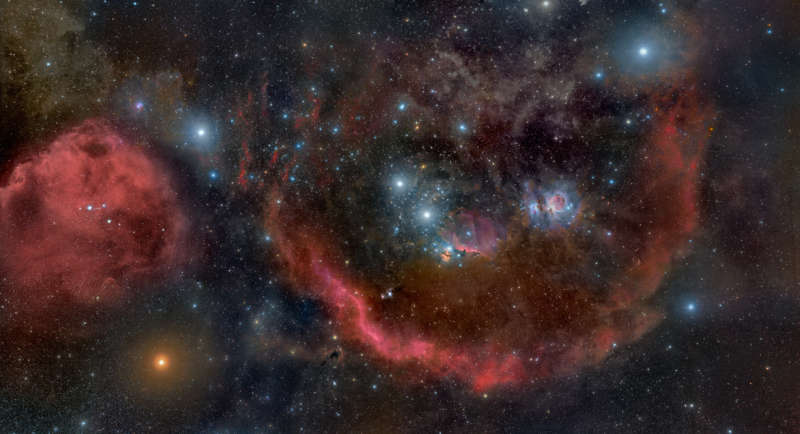Credit & Copyright: Rogelio
Bernal Andreo
Explanation:
Cradled in cosmic dust and glowing hydrogen,
stellar
nurseries in Orion the
Hunter
lie at
the edge of a giant molecular cloud some 1,500 light-years away.
Spanning nearly 25 degrees, this breath-taking vista
stretches across the well-known constellation
from head to toe
(left to right).
The Great Orion
Nebula, the closest large star forming region, is right of center.
To its left are the
Horsehead Nebula,
M78, and
Orion's belt stars.
Sliding your cursor over the picture will also find
red giant Betelgeuse at the hunter's shoulder,
bright blue Rigel
at his foot, and the glowing Lambda Orionis
(Meissa) nebula at the far left, near Orion's head.
Of course, the Orion Nebula and bright stars are
easy to see with the
unaided eye, but dust clouds and emission from the extensive interstellar
gas in this nebula-rich complex,
are too faint and much harder to record.
In this mosaic of broadband telescopic images, additional image
data acquired with a narrow
hydrogen alpha filter was used to
bring out the pervasive tendrils of energized
atomic hydrogen gas and the arc of the giant
Barnard's Loop.
1999 2000 2001 2002 2003 2004 2005 2006 2007 2008 2009 2010 2011 2012 2013 2014 2015 2016 2017 2018 2019 2020 2021 2022 2023 2024 2025 |
Yanvar' Fevral' Mart Aprel' Mai Iyun' Iyul' Avgust Sentyabr' Oktyabr' Noyabr' Dekabr' |
NASA Web Site Statements, Warnings, and Disclaimers
NASA Official: Jay Norris. Specific rights apply.
A service of: LHEA at NASA / GSFC
& Michigan Tech. U.
|
Publikacii s klyuchevymi slovami:
Orion - Orion Nebula - Horsehead Nebula - M 87 - hydrogen - Orion - Tumannost' Oriona - tumannost' Konskaya Golova - vodorod
Publikacii so slovami: Orion - Orion Nebula - Horsehead Nebula - M 87 - hydrogen - Orion - Tumannost' Oriona - tumannost' Konskaya Golova - vodorod | |
Sm. takzhe:
Vse publikacii na tu zhe temu >> | |
